headrest FIAT TALENTO 2018 Owner handbook (in English)
[x] Cancel search | Manufacturer: FIAT, Model Year: 2018, Model line: TALENTO, Model: FIAT TALENTO 2018Pages: 232, PDF Size: 5.54 MB
Page 116 of 232
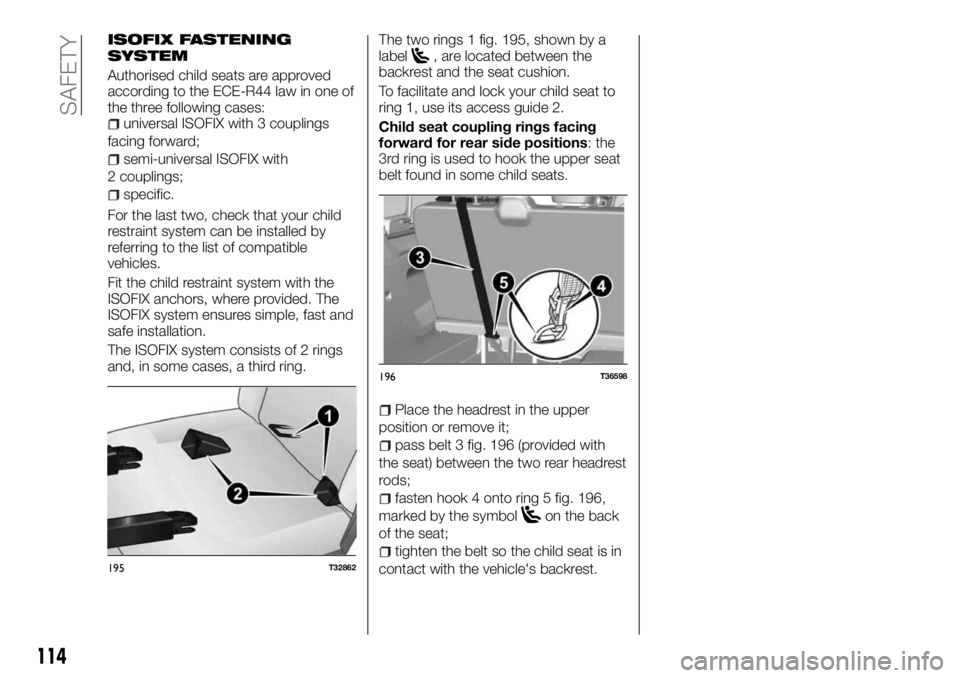
ISOFIX FASTENING
SYSTEM
Authorised child seats are approved
according to the ECE-R44 law in one of
the three following cases:
universal ISOFIX with 3 couplings
facing forward;
semi-universal ISOFIX with
2 couplings;
specific.
For the last two, check that your child
restraint system can be installed by
referring to the list of compatible
vehicles.
Fit the child restraint system with the
ISOFIX anchors, where provided. The
ISOFIX system ensures simple, fast and
safe installation.
The ISOFIX system consists of 2 rings
and, in some cases, a third ring.The two rings 1 fig. 195, shown by a
label
, are located between the
backrest and the seat cushion.
To facilitate and lock your child seat to
ring 1, use its access guide 2.
Child seat coupling rings facing
forward for rear side positions: the
3rd ring is used to hook the upper seat
belt found in some child seats.
Place the headrest in the upper
position or remove it;
pass belt 3 fig. 196 (provided with
the seat) between the two rear headrest
rods;
fasten hook 4 onto ring 5 fig. 196,
marked by the symbol
on the back
of the seat;
tighten the belt so the child seat is in
contact with the vehicle's backrest.195T32862
196T36598
114
SAFETY
Page 118 of 232
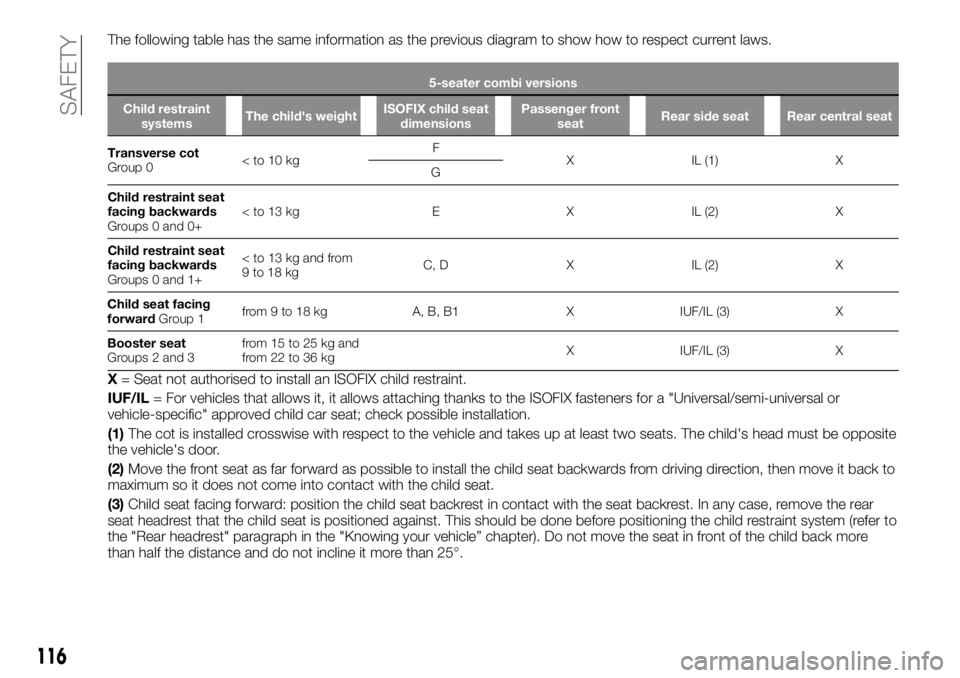
The following table has the same information as the previous diagram to show how to respect current laws.
5-seater combi versions
Child restraint
systemsThe child's weightISOFIX child seat
dimensionsPassenger front
seatRear side seat Rear central seat
Transverse cot
Group 0
G
Child restraint seat
facing backwards
Groups 0 and 0+
facing backwards
Groups 0 and 1+
Child seat facing
forwardGroup 1from 9 to 18 kg A, B, B1 X IUF/IL (3) X
Booster seat
Groups 2 and 3from 15 to 25 kg and
from 22 to 36 kgX IUF/IL (3) X
X= Seat not authorised to install an ISOFIX child restraint.
IUF/IL= For vehicles that allows it, it allows attaching thanks to the ISOFIX fasteners for a "Universal/semi-universal or
vehicle-specific" approved child car seat; check possible installation.
(1)The cot is installed crosswise with respect to the vehicle and takes up at least two seats. The child's head must be opposite
the vehicle's door.
(2)Move the front seat as far forward as possible to install the child seat backwards from driving direction, then move it back to
maximum so it does not come into contact with the child seat.
(3)Child seat facing forward: position the child seat backrest in contact with the seat backrest. In any case, remove the rear
seat headrest that the child seat is positioned against. This should be done before positioning the child restraint system (refer to
the "Rear headrest" paragraph in the "Knowing your vehicle” chapter). Do not move the seat in front of the child back more
than half the distance and do not incline it more than 25°.
116
SAFETY
Page 120 of 232
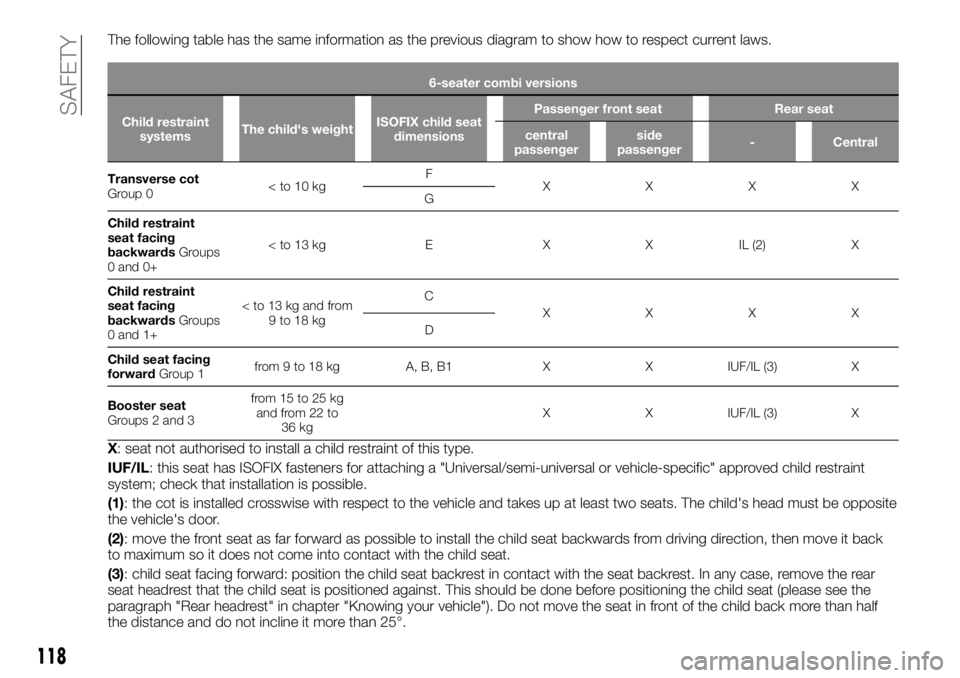
The following table has the same information as the previous diagram to show how to respect current laws.
6-seater combi versions
Child restraint
systemsThe child's weightISOFIX child seat
dimensionsPassenger front seat Rear seat
central
passengerside
passenger- Central
Transverse cot
Group 0
G
Child restraint
seat facing
backwardsGroups
0 and 0+
seat facing
backwardsGroups
0 and 1+
XXXX
D
Child seat facing
forwardGroup 1from 9 to 18 kg A, B, B1 X X IUF/IL (3) X
Booster seat
Groups 2 and 3from 15 to 25 kg
and from 22 to
36 kgX X IUF/IL (3) X
X: seat not authorised to install a child restraint of this type.
IUF/IL: this seat has ISOFIX fasteners for attaching a "Universal/semi-universal or vehicle-specific" approved child restraint
system; check that installation is possible.
(1): the cot is installed crosswise with respect to the vehicle and takes up at least two seats. The child's head must be opposite
the vehicle's door.
(2): move the front seat as far forward as possible to install the child seat backwards from driving direction, then move it back
to maximum so it does not come into contact with the child seat.
(3): child seat facing forward: position the child seat backrest in contact with the seat backrest. In any case, remove the rear
seat headrest that the child seat is positioned against. This should be done before positioning the child seat (please see the
paragraph "Rear headrest" in chapter "Knowing your vehicle"). Do not move the seat in front of the child back more than half
the distance and do not incline it more than 25°.
118
SAFETY
Page 122 of 232
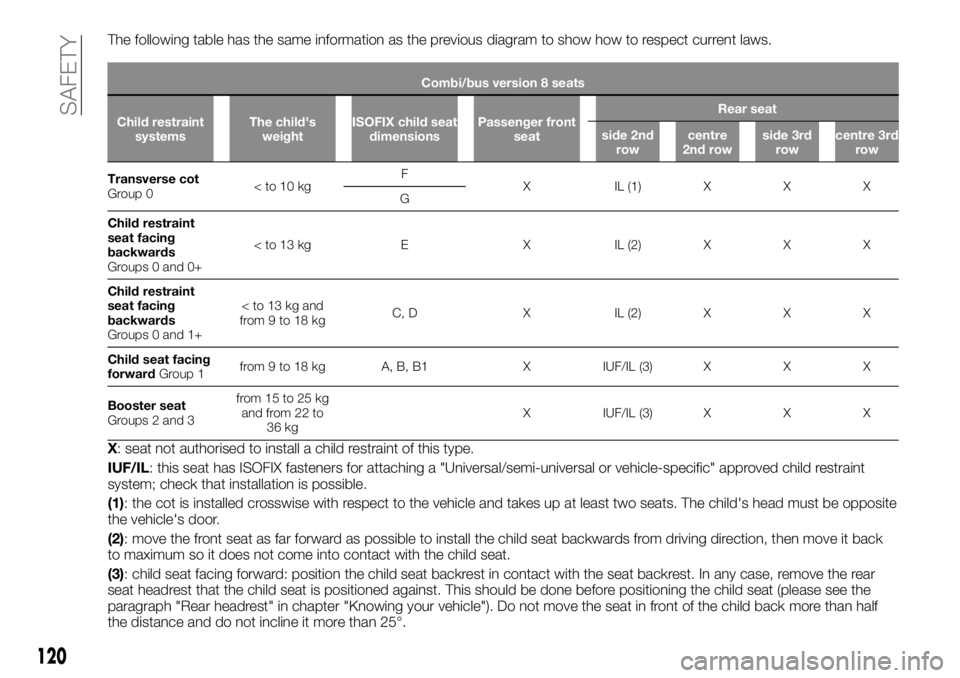
The following table has the same information as the previous diagram to show how to respect current laws.
Combi/bus version 8 seats
Child restraint
systemsThe child's
weightISOFIX child seat
dimensionsPassenger front
seatRear seat
side 2nd
rowcentre
2nd rowside 3rd
rowcentre 3rd
row
Transverse cot
Group 0
G
Child restraint
seat facing
backwards
Groups 0 and 0+
seat facing
backwards
Groups 0 and 1+
Child seat facing
forwardGroup 1from 9 to 18 kg A, B, B1 X IUF/IL (3) X X X
Booster seat
Groups 2 and 3from 15 to 25 kg
and from 22 to
36 kgX IUF/IL (3) X X X
X: seat not authorised to install a child restraint of this type.
IUF/IL: this seat has ISOFIX fasteners for attaching a "Universal/semi-universal or vehicle-specific" approved child restraint
system; check that installation is possible.
(1): the cot is installed crosswise with respect to the vehicle and takes up at least two seats. The child's head must be opposite
the vehicle's door.
(2): move the front seat as far forward as possible to install the child seat backwards from driving direction, then move it back
to maximum so it does not come into contact with the child seat.
(3): child seat facing forward: position the child seat backrest in contact with the seat backrest. In any case, remove the rear
seat headrest that the child seat is positioned against. This should be done before positioning the child seat (please see the
paragraph "Rear headrest" in chapter "Knowing your vehicle"). Do not move the seat in front of the child back more than half
the distance and do not incline it more than 25°.
120
SAFETY
Page 125 of 232
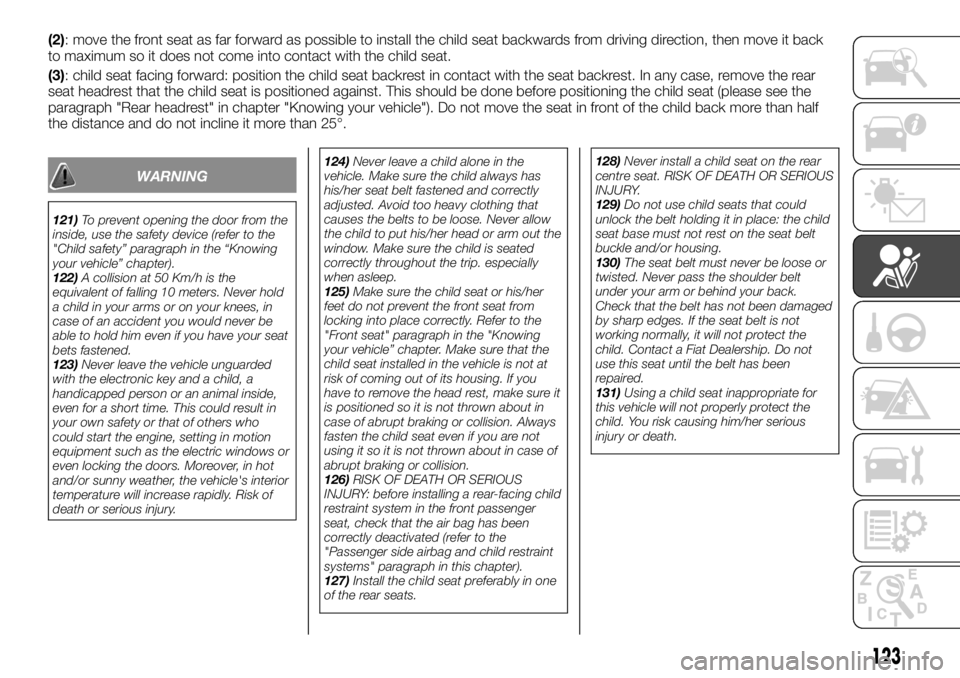
(2): move the front seat as far forward as possible to install the child seat backwards from driving direction, then move it back
to maximum so it does not come into contact with the child seat.
(3): child seat facing forward: position the child seat backrest in contact with the seat backrest. In any case, remove the rear
seat headrest that the child seat is positioned against. This should be done before positioning the child seat (please see the
paragraph "Rear headrest" in chapter "Knowing your vehicle"). Do not move the seat in front of the child back more than half
the distance and do not incline it more than 25°.
WARNING
121)To prevent opening the door from the
inside, use the safety device (refer to the
"Child safety” paragraph in the “Knowing
your vehicle” chapter).
122)A collision at 50 Km/h is the
equivalent of falling 10 meters. Never hold
a child in your arms or on your knees, in
case of an accident you would never be
able to hold him even if you have your seat
bets fastened.
123)Never leave the vehicle unguarded
with the electronic key and a child, a
handicapped person or an animal inside,
even for a short time. This could result in
your own safety or that of others who
could start the engine, setting in motion
equipment such as the electric windows or
even locking the doors. Moreover, in hot
and/or sunny weather, the vehicle's interior
temperature will increase rapidly. Risk of
death or serious injury.124)Never leave a child alone in the
vehicle. Make sure the child always has
his/her seat belt fastened and correctly
adjusted. Avoid too heavy clothing that
causes the belts to be loose. Never allow
the child to put his/her head or arm out the
window. Make sure the child is seated
correctly throughout the trip. especially
when asleep.
125)Make sure the child seat or his/her
feet do not prevent the front seat from
locking into place correctly. Refer to the
"Front seat" paragraph in the "Knowing
your vehicle” chapter. Make sure that the
child seat installed in the vehicle is not at
risk of coming out of its housing. If you
have to remove the head rest, make sure it
is positioned so it is not thrown about in
case of abrupt braking or collision. Always
fasten the child seat even if you are not
using it so it is not thrown about in case of
abrupt braking or collision.
126)RISK OF DEATH OR SERIOUS
INJURY: before installing a rear-facing child
restraint system in the front passenger
seat, check that the air bag has been
correctly deactivated (refer to the
"Passenger side airbag and child restraint
systems" paragraph in this chapter).
127)Install the child seat preferably in one
of the rear seats.128)Never install a child seat on the rear
centre seat. RISK OF DEATH OR SERIOUS
INJURY.
129)Do not use child seats that could
unlock the belt holding it in place: the child
seat base must not rest on the seat belt
buckle and/or housing.
130)The seat belt must never be loose or
twisted. Never pass the shoulder belt
under your arm or behind your back.
Check that the belt has not been damaged
by sharp edges. If the seat belt is not
working normally, it will not protect the
child. Contact a Fiat Dealership. Do not
use this seat until the belt has been
repaired.
131)Using a child seat inappropriate for
this vehicle will not properly protect the
child. You risk causing him/her serious
injury or death.
123
Page 229 of 232
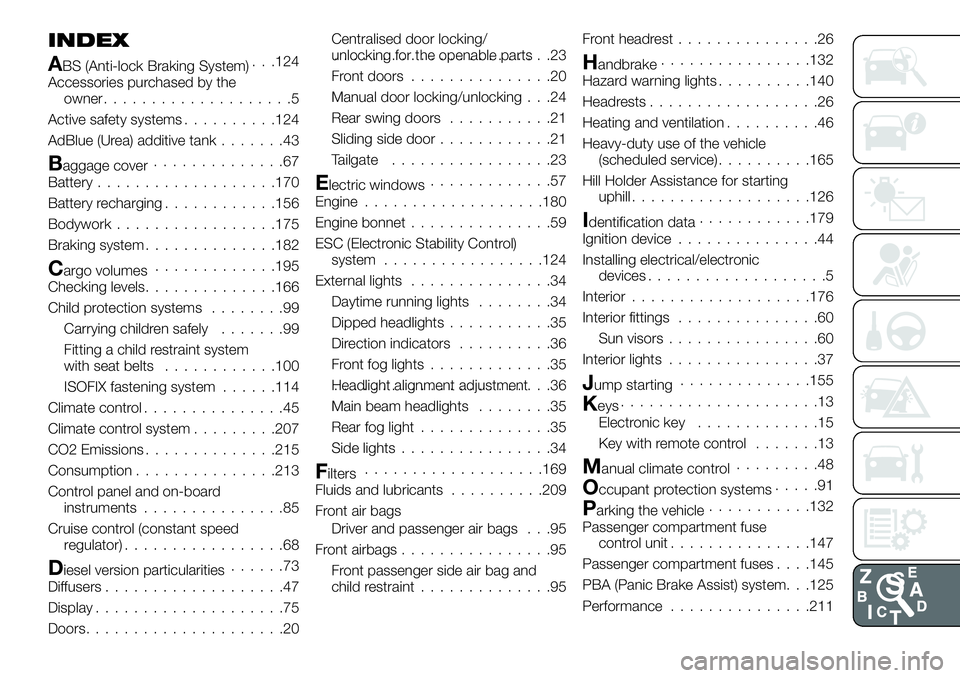
INDEX
ABS (Anti-lock Braking System). . .124
Accessories purchased by the
owner....................5
Active safety systems..........124
AdBlue (Urea) additive tank.......43
Baggage cover..............67
Battery...................170
Battery recharging............156
Bodywork.................175
Braking system..............182
Cargo volumes.............195
Checking levels..............166
Child protection systems........99
Carrying children safely.......99
Fitting a child restraint system
with seat belts............100
ISOFIX fastening system......114
Climate control...............45
Climate control system.........207
CO2 Emissions..............215
Consumption...............213
Control panel and on-board
instruments...............85
Cruise control (constant speed
regulator).................68
Diesel version particularities......73
Diffusers...................47
Display....................75
Doors.....................20Centralised door locking/
unlocking for the openable parts.......................23
Front doors...............20
Manual door locking/unlocking . . .24
Rear swing doors...........21
Sliding side door............21
Tailgate.................23
Electric windows.............57
Engine...................180
Engine bonnet...............59
ESC (Electronic Stability Control)
system.................124
External lights...............34
Daytime running lights........34
Dipped headlights...........35
Direction indicators..........36
Front fog lights.............35
Headlight alignment adjustment.......................36
Main beam headlights........35
Rear fog light..............35
Side lights................34
Filters...................169
Fluids and lubricants..........209
Front air bags
Driver and passenger air bags . . .95
Front airbags................95
Front passenger side air bag and
child restraint..............95Front headrest...............26
Handbrake................132
Hazard warning lights..........140
Headrests..................26
Heating and ventilation..........46
Heavy-duty use of the vehicle
(scheduled service)..........165
Hill Holder Assistance for starting
uphill...................126
Identification data............179
Ignition device...............44
Installing electrical/electronic
devices...................5
Interior...................176
Interior fittings...............60
Sun visors................60
Interior lights................37
Jump starting..............155
Keys.....................13
Electronic key.............15
Key with remote control.......13
Manual climate control.........48
Occupant protection systems.....91
Parking the vehicle...........132
Passenger compartment fuse
control unit...............147
Passenger compartment fuses. . . .145
PBA (Panic Brake Assist) system. . .125
Performance...............211
Page 230 of 232
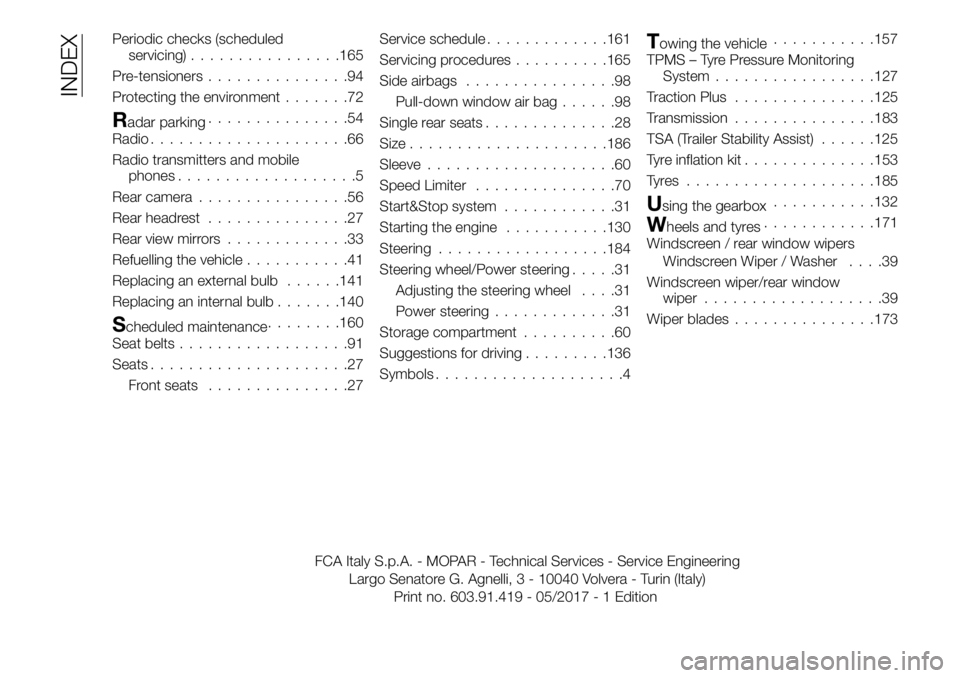
Periodic checks (scheduled
servicing)................165
Pre-tensioners...............94
Protecting the environment.......72
Radar parking...............54
Radio.....................66
Radio transmitters and mobile
phones...................5
Rear camera................56
Rear headrest...............27
Rear view mirrors.............33
Refuelling the vehicle...........41
Replacing an external bulb......141
Replacing an internal bulb.......140
Scheduled maintenance........160
Seat belts..................91
Seats.....................27
Front seats...............27Service schedule.............161
Servicing procedures..........165
Side airbags................98
Pull-down window air bag......98
Single rear seats..............28
Size.....................186
Sleeve....................60
Speed Limiter...............70
Start&Stop system............31
Starting the engine...........130
Steering..................184
Steering wheel/Power steering.....31
Adjusting the steering wheel....31
Power steering.............31
Storage compartment..........60
Suggestions for driving.........136
Symbols....................4
Towing the vehicle...........157
TPMS – Tyre Pressure Monitoring
System.................127
Traction Plus...............125
Transmission...............183
TSA (Trailer Stability Assist)......125
Tyre inflation kit..............153
Tyres ....................185
Using the gearbox...........132
Wheels and tyres............171
Windscreen / rear window wipers
Windscreen Wiper / Washer....39
Windscreen wiper/rear window
wiper...................39
Wiper blades...............173
INDEX
FCA Italy S.p.A. - MOPAR - Technical Services - Service Engineering
Largo Senatore G. Agnelli, 3 - 10040 Volvera - Turin (Italy)
Print no. 603.91.419 - 05/
2017 - 1 Edition